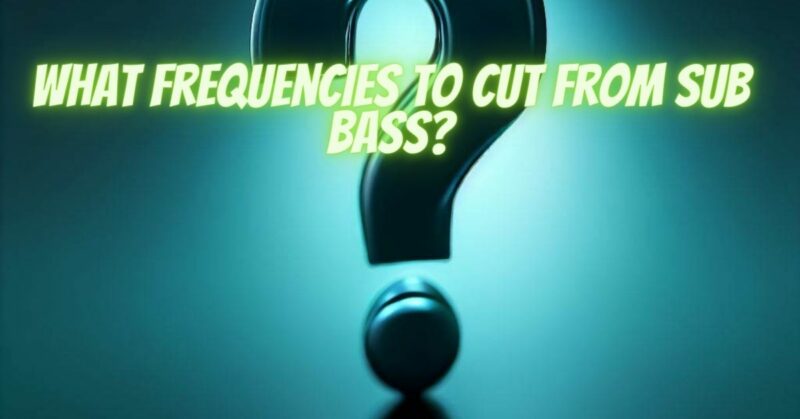Sub bass is the heartbeat of many music genres, providing the foundation for powerful, rumbling lows. However, achieving a clean and defined sub bass sound can be a delicate balancing act. In this article, we’ll explore the frequencies that are often cut from sub bass to improve clarity, prevent muddiness, and enhance the overall mix.
Understanding the Role of Sub Bass
Sub bass frequencies typically range from around 20 Hz to 60 Hz, producing the deep, resonant tones that are felt more than heard. While they are essential for creating a powerful low-end presence, excessive sub bass can lead to issues such as muddiness, phase cancellation, and an imbalanced mix.
Frequencies to Cut from Sub Bass
- Low-End Muddiness (20 Hz – 100 Hz): The extreme sub-bass frequencies (20 Hz – 40 Hz) can be cut to reduce excessive rumble and muddiness, especially in tracks with heavy bass elements. Cutting frequencies below 20 Hz is common, as they often contain unwanted noise and subsonic content that can overload speakers and subwoofers without contributing to the music’s audible content.
- Kick Drum Clash (60 Hz – 100 Hz): To create separation between the sub bass and the kick drum, a common practice is to cut a narrow frequency range around the fundamental frequency of the kick drum, which typically resides in the 60 Hz – 100 Hz range. This cut allows the kick and sub bass to coexist without clashing, resulting in a cleaner and more defined low end.
- Mud and Muddiness (100 Hz – 250 Hz): The lower midrange frequencies (100 Hz – 250 Hz) can become muddy and cluttered if left unchecked. Cutting these frequencies slightly can help reduce muddiness and create more space in the mix for other elements to breathe.
- Boxiness (250 Hz – 500 Hz): Frequencies in the 250 Hz – 500 Hz range can contribute to a “boxy” or hollow sound. Cutting or attenuating these frequencies can improve the clarity and balance of the sub bass, making it sound more focused and defined.
Tools for Cutting Frequencies
There are various tools and techniques to cut unwanted frequencies from sub bass:
- Equalization (EQ): Parametric EQs or graphic EQs allow precise control over the frequencies to be cut. A high-pass filter or a low shelf filter can effectively remove unwanted sub-bass content.
- Sidechain Compression: Sidechain compression can be used to dynamically reduce the sub bass’s volume when the kick drum hits. This technique helps create space for the kick and prevents conflicts in the low end.
- Multiband Compression: Multiband compressors allow you to target specific frequency ranges, including the sub-bass frequencies, for compression or reduction, effectively controlling their presence in the mix.
- Subtractive Synthesis: When synthesizing sub bass sounds, you can shape the sound by subtracting unwanted frequencies during the sound design process, resulting in a cleaner and more focused sub bass.
Listening and Fine-Tuning
Ultimately, the decision of which frequencies to cut from sub bass should be based on careful listening and consideration of the specific mix and genre. While these frequency ranges provide a starting point, every mix is unique, and adjustments should be made to suit the context and artistic intent.
Knowing which frequencies to cut from sub bass is a valuable skill for achieving a clean and defined low-end in your music production. By understanding the potential trouble spots and using appropriate tools and techniques, you can sculpt your sub bass to sit perfectly in the mix, ensuring that it enhances rather than overwhelms your music.


